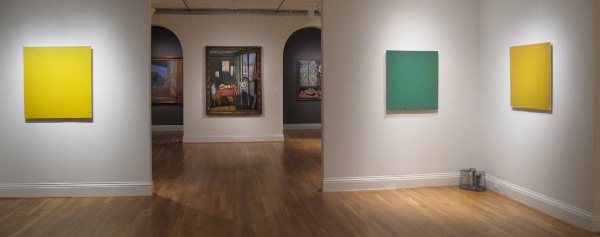At first glance you may not consider the curatorial placement of Joseph Marioni’s Yellow Painting (2003) and Green Painting (2002) flanking Henri Matisse’s Studio, Quai Saint-Michel (1916) in the next gallery. But look again . . .

Henri Matisse's Studio, Quai Saint-Michel (1916) on view in the gallery just beyond Joseph Marioni's green and yellow paintings. Photo: Sarah Osborne Bender
When standing and simultaneously viewing all three paintings from a distance, the shared palette becomes very apparent. Marioni’s paintings begin to vibrate against the walls. The green and yellow echo the edges of the Studio window and ceiling. The red tapestry under Matisse’s Italian model, Lorette, suddenly comes to life. Marioni’s rectangular canvases mimic the window panes that captured the view onto Quai Saint-Michel. In our galleries, rather than peering out on the Seine or the palace of Justice, we look further into the layers and depths of color.
On a tour at the Phillips in October, the artist expressed the significance of Matisse in the installation, describing Studio, Quai Saint-Michel as a “key piece.” According to Marioni, Matisse was one of the first artists to champion early modern color, the emotional context of color as well as the shift from representation to abstraction.
Alice Shih, Gallery Educator


Thank you for this post. I had the same reaction to the Matisse and Marioni placement as you describe. I had a difficult time explaining that to a friend. Now I can just show her your post. However, you have to see the works so placed in person to experience this. Even your good photos do not adequately convey the total effect.